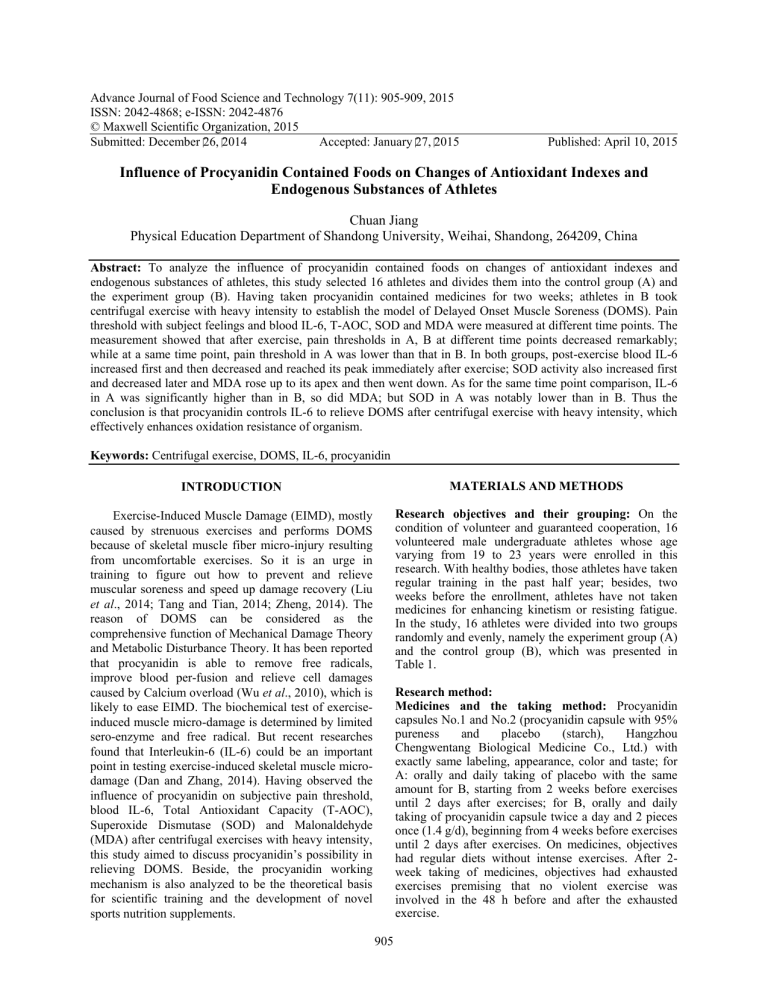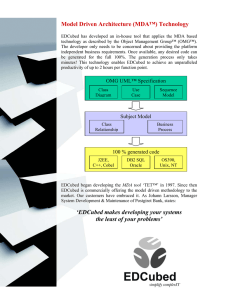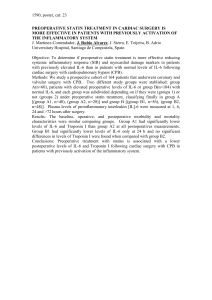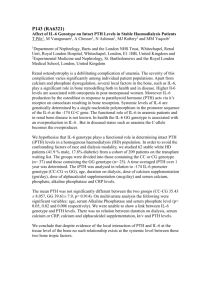Advance Journal of Food Science and Technology 7(11): 905-909, 2015

Advance Journal of Food Science and Technology 7(11): 905-909, 2015
ISSN: 2042-4868; e-ISSN: 2042-4876
© Maxwell Scientific Organization, 2015
Submitted: December
26, 2014 Accepted: January 27, 2015
Published: April 10, 2015
Influence of Procyanidin Contained Foods on Changes of Antioxidant Indexes and
Endogenous Substances of Athletes
Chuan Jiang
Physical Education Department of Shandong University, Weihai, Shandong, 264209, China
Abstract: To analyze the influence of procyanidin contained foods on changes of antioxidant indexes and endogenous substances of athletes, this study selected 16 athletes and divides them into the control group (A) and the experiment group (B). Having taken procyanidin contained medicines for two weeks; athletes in B took centrifugal exercise with heavy intensity to establish the model of Delayed Onset Muscle Soreness (DOMS). Pain threshold with subject feelings and blood IL-6, T-AOC, SOD and MDA were measured at different time points. The measurement showed that after exercise, pain thresholds in A, B at different time points decreased remarkably; while at a same time point, pain threshold in A was lower than that in B. In both groups, post-exercise blood IL-6 increased first and then decreased and reached its peak immediately after exercise; SOD activity also increased first and decreased later and MDA rose up to its apex and then went down. As for the same time point comparison, IL-6 in A was significantly higher than in B, so did MDA; but SOD in A was notably lower than in B. Thus the conclusion is that procyanidin controls IL-6 to relieve DOMS after centrifugal exercise with heavy intensity, which effectively enhances oxidation resistance of organism.
Keywords: Centrifugal exercise, DOMS, IL-6, procyanidin et al
INTRODUCTION
Exercise-Induced Muscle Damage (EIMD), mostly caused by strenuous exercises and performs DOMS because of skeletal muscle fiber micro-injury resulting from uncomfortable exercises. So it is an urge in training to figure out how to prevent and relieve muscular soreness and speed up damage recovery (Liu
., 2014; Tang and Tian, 2014; Zheng, 2014). The reason of DOMS can be considered as the comprehensive function of Mechanical Damage Theory and Metabolic Disturbance Theory. It has been reported that procyanidin is able to remove free radicals, improve blood per-fusion and relieve cell damages caused by Calcium overload (Wu et al ., 2010), which is likely to ease EIMD. The biochemical test of exerciseinduced muscle micro-damage is determined by limited sero-enzyme and free radical. But recent researches found that Interleukin-6 (IL-6) could be an important point in testing exercise-induced skeletal muscle microdamage (Dan and Zhang, 2014). Having observed the influence of procyanidin on subjective pain threshold, blood IL-6, Total Antioxidant Capacity (T-AOC),
Superoxide Dismutase (SOD) and Malonaldehyde
(MDA) after centrifugal exercises with heavy intensity, this study aimed to discuss procyanidin’s possibility in relieving DOMS. Beside, the procyanidin working mechanism is also analyzed to be the theoretical basis for scientific training and the development of novel sports nutrition supplements.
905
MATERIALS AND METHODS
Research objectives and their grouping: On the condition of volunteer and guaranteed cooperation, 16 volunteered male undergraduate athletes whose age varying from 19 to 23 years were enrolled in this research. With healthy bodies, those athletes have taken regular training in the past half year; besides, two weeks before the enrollment, athletes have not taken medicines for enhancing kinetism or resisting fatigue.
In the study, 16 athletes were divided into two groups randomly and evenly, namely the experiment group (A) and the control group (B), which was presented in
Table 1.
Research method:
Medicines and the taking method: Procyanidin capsules No.1 and No.2 (procyanidin capsule with 95% pureness and placebo (starch), Hangzhou
Chengwentang Biological Medicine Co., Ltd.) with exactly same labeling, appearance, color and taste; for
A: orally and daily taking of placebo with the same amount for B, starting from 2 weeks before exercises until 2 days after exercises; for B, orally and daily taking of procyanidin capsule twice a day and 2 pieces once (1.4 g/d), beginning from 4 weeks before exercises until 2 days after exercises. On medicines, objectives had regular diets without intense exercises. After 2week taking of medicines, objectives had exhausted exercises premising that no violent exercise was involved in the 48 h before and after the exhausted exercise.
Adv. J. Food Sci. Technol., 7(11): 905-909, 2015
Table 1: The grouping of athletes in the experiment
Grading programs
----------------------------------------------------------------------------------------
Groups
A
B
Ages (year)
21.3±2.1
20.7±1.7
Weights (kg)
65.3±3.5
64.1±3.2
Heights (cm)
175.4±3.8
176.1±3.3
Grade 2
2
2
Table 2: Comparison of objectives’ subjective pain threshold in two groups
Grade 3
6
6
Track and Field
5
5
Basketball
3
3
Groups
A
B
Inter-group
Different time points
Inter-group comparisons at different time points
Before exercise (n = 8)
185.4±11.7
184.7±14.8
After exercise (n = 8)
----------------------------------------------------------------------------
Immediately
123±14.9^^
49.3±12.8^*
F = 59.55 P = 0.00
F = 254.51 P = 0.00
F = 462.40 P = 0.00
24 h
77.8±13.4^^``
98.2±9.8^^``*
48 h
117.3±15.7^^##
134.1±10.6^^#*
^: p<0.05; ^^: p<0.01vs pre-exercise; `: p<0.05; ``: p<0.01vs instant; #: p<0.05; ##: p<0.01vs24h; *: p<0.05; **: p<0.01vs the same phase of group A
The establishment of athletes DOMS model: Before the exercise, athletes took adaptable activity for 5 min in a treadmill with -10° falling gradient and 6 km/h speed and the formal experiment started after 3-min rest. Planning for exhausted exercises: objectives took exercises with increasing load in mercury 4.0 treadmill made in German. Started from 6 km/h, the speed and variance analysis with repeated determination was performed in the comparisons of different time points.
Besides, t test showed up in inter-group comparisons. If p<0.05, the difference was considered as statistically significant.
RESULTS increased 2 km/h each 3 min unless the speed reached
16 km/h or objectives’ heart beating maintained 170 times/min and kept the final speed. If objectives could not go on exercising with repeated encouragement, the
Subjective pain threshold changes after exercises:
After exercise, both subjective pain thresholds in A and
B reduced at all time points and reached the bottom 24 exercise ceased.
Specimen collection and processing and index measurement: Take 4 mL venous blood from median cubit at different time points respectively which referred to before medicine taking, before exercise, immediately after exercise, 24 h after exercise and 48 h after exercise. Then test IL-6 with EDTA anticoagulant agent and determine T-AOC, SOD and MDA after serum centrifugation. Index measurement method: iron reduction process for T-AOC determination, xanthine oxidase method for SOD and thiobarbituric (TBA) for
MDA. Determination method of subjective pain threshold at different time points after the exercise: selfmade tenderness instrument. To be specific, the advanced instrument originated from the method proposed by Lamb, stated by (Zhang et al ., 2006) based on the theoretical model by (Sun and Wang, 2013). In the determination process, objectives were asked to lie prostrate with straight knee joint. Then according to the method of blood pressure determination, the mercury manometer’s cuff, whose bottom edge was horizontally connected to muscle tendon and belly (near Chengshan point), was tied up to athletes’ calves. Make compression until musculi triceps surae felt pains and record the graduations of mercury manometer which was considered as objectives’ subjective pain thresholds.
Data processing: Data measured were expressed as mean±SD. SPSS 13.0 was adopted in statistical analysis h later. As for the same time-point comparison, data in
A were much lower than data in B, which was presented in Table 2.
Athletes’ blood indexes after exercise:
IL-6 changes: indexes than B. Please refer to Table 3.
In both groups, IL-6 first increased and then decreased with its peak in the immediate point after exercise. In A, post-exercise indexes at different time points were much higher than those before exercise, while the immediate indexes after exercise were remarkably higher than indexes in 24 h and 48 h after exercise; in B, the immediate indexes after exercise were notably higher than indexes at other time points among which significant difference was not noticed; at a same time point, A witnessed higher
Serum T-AOC changes: Post-exercise serum T-AOC tended to climb up in both groups. Significantly higher than pre-exercise level and immediate level after exercise, T-AOC in A upped to its apex 48 h after exercise. In B, T-AOC after exercise immediately rose up, while post-exercise indexes were evidently higher than pre-exercise ones at all time points. When turned to same time point comparison after exercise, indexes of B were proved to be higher than A, which could be noticed from Table 4.
SOD activity changes: In A, immediate SOD after exercise flied to its peak that was much higher than any other time points which did not have notable
906
Adv. J. Food Sci. Technol., 7(11): 905-909, 2015
Table 3: Comparison of objectives’ IL-6 in two groups at different time points
After exercise(n = 8)
--------------------------------------------------------------------------
Groups
A
B
Inter-group
Different time points
Inter-group comparisons at different time points
Before exercise (n = 8)
12.6±3.8
13.1±2.8
Immediately
84±18.7^^
40.5±19.6^**
F = 73.524 P = 0.000
F = 387.227 P = 0.000
F = 156.471 P = 0.000
24 h
34.7±6.5^`
13.9±4.7`**
48 h
35.4±11.2^`
12.4±4.1`^^
^: p<0.05; ^^: p<0.01vs pre-exercise; `: p<0.05, ``: p<0.01vs instant; *: p<0.05, **: p<0.01vs the same phase of group A
Table 4: Comparison of objectives’ T-AOC in two groups at different time points
After exercise(n = 8)
-------------------------------------------------------------------------
Groups
A
B
Inter-group
Different time points
Inter-group comparisons at different time points
Before exercise (n = 8)
10.7±1.2
11.3±0.8
Immediately
10.4±1.3
15.5±2.1^^**
F = 73.524 P = 0.000
F = 387.227 P = 0.000
F = 156.471 P = 0.000
24 h
10.9±1.2
48 h
13.4±0.7^`
15.1±1.5^^** 16.4±1.9^^**
^: p<0.05; ^^: p<0.01vs pre-exercise; `: p<0.05; ``: p<0.01vs instant; *: p<0.05; **: p<0.01vs the same phase of group A
Table 5: Comparison of objectives’ serum SOD in two groups at different time points
Groups
A
B
Inter-group
Different time points
Inter-group comparisons at different time points
Before exercise (n = 8)
60.7±4.7
59.3±3.9
Table 6: Comparison of objectives’ serum MDA in two groups at different time points
After exercise(n = 8)
--------------------------------------------------------------------------
Immediately 24 h 48 h
7.4±3.3^
81.5±4.7^^*
F = 53.819 P = 0.000
F = 582.228 P = 0.000
F = 161.481 P = 0.000
57.9±5.7``
72.4±2.5^`**
55.4±6.7``
68.9±4.4^`*
Groups
A
B
Inter-group
Different time points
Inter-group comparisons at different time points
Before exercise (n = 8)
4.3±0.4
4.3±0.5
After exercise(n = 8)
--------------------------------------------------------------------------
Immediately
5.1±0.3^^
24 h
5.3±0.4^^
48 h
5.0±0.3^`
5.3±0.2^*
F = 93.819 P = 0.000
F = 352.228 P = 0.000
F = 101.481 P = 0.000
4.2±0.3`** 4.2±0.1``** differences. Post-exercise SOD activity in B presented as up-first-down-then; while at any time points, postexercise SOD was remarkably higher than pre-exercise.
As for the comparison between two groups, as shown in
Table 5, pre-exercise SOD did not indicate significant difference; but after exercise, B was found with much higher SOD activity at any time points (Table 5).
Serum MDA concentration changes: At any time points in A, post-exercise MDA, which peaked 48 h later, was much higher than that before exercise. In the experiment, MDA reached its apex immediately after exercise and then went down; while its immediate postexercise level was notably greater than other time points which had no significant differences. Compared to B, A possessed higher level of MDA, which could be found in Table 6.
DISCUSSION
The influence of procyanidin on athletes’ postexercise DOMS: Featured by DOMS, EIMD refers to the micro-injury of skeletal muscle fiber resulting from
907 uncomfortable exercises, which generally occurs 24 h after exercise (delayed onset), peaks 24~48 h after exercise and can last for 5~7 days or even longer. The deeper and further studies of EIMD lead to various theories of DOMS producing mechanism, such as
“Metabolic Theory” “Ischemia-spasm Theory” and
“Damage Theory of Muscle Fiber Structure”. Generally speaking, mechanical injury plays the leading role in the early stage of EIMD, followed by the effect displayed by metabolism.
Procyanidin, mainly extracted from grape seeds, is a common plant poly-phenol, functioning in free radical removal, blood pre-fusion improvement and relief of cell damages caused by Calcium overload. Highlighted by powerful oxidation resistance, procyanidin is a free radical scavenger more effective than vitamin C (VC) and vitamin E (VE). Speaking of anti-oxidation in body and free radical removal, procyanidin is 50 times effective than VC and 20 times effective than VE
(Zhang, 2014; Duan et al ., 2014). As for the reason of
DOMS, it is possible that procyanidin improves metabolism to relieve DOMS based on its protection of muscle cell structures and functions. It was informed in
Adv. J. Food Sci. Technol., 7(11): 905-909, 2015 this study that subjective pain thresholds of musculi triceps surae in post-exercise time points of B were lower than that in A, indicating the effect of peocyanidin in reducing DOMS resulting from heavily intense centrifugal exercise.
The influence of procyanidin on athletes’ postexercise blood IL-6: Primarily born in immune system,
IL-6 regulates immune responses and gets involved in acute phase reaction and hemopoiesis. Some research found that the apex value of IL-6 concentration was males from physical education department have endurance exercises in a moderate intensity treadmill until they felt fatigue and then observed their serum T-
AOC changes. It was found that T-AOC remarkably increased immediately after exercise and remained higher than normal level 24 h after exercise, which proved that exercises can improve T-AOC. As for T-
AOC in this experiment, it did not have obvious difference in both groups before the exercise; and postexercise T-AOC in B at any time point was much higher than in A. The results strongly suggested that bound with chronic muscle injury (Niu, 2013). Via studies, (Song, 2013) witnessed obvious ultrastructure damage of rat skeletal muscle once the rat completed a centrifugal exercise. Blood IL-6 got its peaks twice, namely immediately after exercise and 72 h after exercise, performing as two single peaks. It was possible that two peaks, respectively were related to exercise stress and muscle damage from intense exercises, which could be regarded as the index to evaluate EIMD.
In this experiment, blood IL-6 in A maintained its apex immediately after exercise and remained higher than pre-exercise ones in the 24 and 48 h after exercise.
Thus the theory was that exercise stress led to the great increase of IL-6 caused by violent centrifugal exercise procyanidin did improve T-AOC to decrease injuries caused by oxidation stress to protect tissues.
The influence of procyanidin on athletes’ postexercise SOD activity: Various tissues, especially endogenous free radicals in skeletal muscle, will be enhanced when body has exercise stress. SOD mainly functions in catalyzing disproportionation of superoxide anion, the initial product in active oxygen formation, so
SOD is considered as the forefront of active oxygen defense. This experiment showed that pre-exercise
SOD activity in both groups did not vary from each other with a great difference. But after exercise, SOD in
B immediately upped in a evident way and it at any and IL-6 decreased with the disappearance of exercise stress. Muscle damage, a key factor for IL-6 maintain, enabled post-exercise IL-6 to remain in a high level, even 24 and 48 h later. In B, immediate IL-6 after exercise was higher than other time points and IL-6 turned back to pre-exercise level 24 and 48 h after exercise. Compared to A, IL-6 at any time points of B was much higher, indicating that procyanidin was effective in reducing exercise stress and inflammatory reaction caused by intense centrifugal exercises. time points were higher than in A. Thus the conclusion was that procyanidin had the ability to enhance oxidation resistance through the improvement of SOD activity.
The influence of procyanidin on athletes’ postexercise MDA: MDA, as the representative product of lipid per-oxidation, is the sensitive index of free radical metabolism, whose content can objectively reflect free radical level. It has been reported that serum MDA increased (Wei et al ., 2012; Zuo et al ., 2013; Li et al ., Besides, procyanidin lessened the change and damage degree of membrane permeability to promote cell membrane repair, finally protecting the functional completeness of cell membrane structure.
The influence of procyanidin on athletes’ postexercise T-AOC: Body resistance of oxidation is depending on the protection of anti-oxidation agents
2013) because violent exercise resulted in skeletal muscle damage or because exercise brought the increase of active oxygen, the enhance of per-oxidation and the occurrence of oxidation stress. To reduce postexercise MDA, anti-oxidation agents should be supplied, especially combined anti-oxidation agents which could ease the increase of MDA after centrifugal and the dynamic balance of lipid per-oxidation.
Currently, a common research method for reflecting tissue capability of oxidation resistance is the determination of specific anti-oxidation components, such as SOD and GSH-PX. However, changes of signal component can not accurately mirror tissue capability changes of oxidation resistance and occurrences of oxidation damages. On the other hand, T-AOC indicates body capability of overall anti-oxidation and exercise with heavy intensity. As shown in this experiment, serum MDA enhanced in A and B, but the latter was greater than the former, indicating that medicines advanced anti-oxidation resistance to remove exercise induced free radicals. If so, it was benefit for cells to resist free radical damages, protect lipid membrane and maintain cell completeness and normally physiological functions. free radical removal, which is especially meaningful in evaluating the damage of body oxidation caused by exercise stress. So for single antioxidant index, T-AOC is incomparable.
In recent years, T-AOC has been applied in the
CONCLUSION
Post-exercise subjective pain threshold in B is greater than that in A at any time point and the field of sports and free radical. Zhao et al . (2012) made
908 difference is significant. This suggests that procyanidin
Adv. J. Food Sci. Technol., 7(11): 905-909, 2015 can relieve centrifugal exercise induced DOMS. In addition, blood IL-6 in B after exercise is much lower than IL-6 in A at any time point, stating clearly that procyanidin effectively inhibit the increase of IL-6 resulting from heavily intense centrifugal exercise. As for T-AOC and SOD activity after exercise, B witnesses greater level than A; yet MDA goes the opposite way. This delivers the message that
Sun, Y. and R. Wang, 2013. Determination indexes of delayed onset muscle soreness and its changing characteristics. Sport, 11: 47-49.
Song, W.J., 2013. Dynamic change of rat inflammation and serum iron after acute and exhausted exercises.
Hebei Normal Univ., 2013.
Tang, S.X. and H.L. Tian, 2014. Research status of
DOMS removal method. Jin Tian J., 403: 476. procyanidin improves SOD activity to enhance antioxidation resistance, finally reducing serum MDA.
Therefore, it can be concluded that procyanidin does good in easing free radical increase caused by exercises and resisting exercise-induced fatigue.
Wu, Y.J., Y.F. Liang and J.N. Dong, 2010. Research progress of procyanidin in grape seeds. J. Trop.
Med., 08: 1025-1028.
Wei, H.C., X.X. Sun, G.Q. Bing and R. Sun, 2012.
Influence of different eccentric exercise load in tissue structure of skeletal muscle and enzyme
REFERENCES
Duan, G.P., X.L. Liu and P.W. Zhao, 2014. Advances in the pharmacology research of grape seed proanthocyanidin. Global Trad. Chin. Med., 04:
313-316.
Dan, J. and H. Zhang, 2014. Influence of antioxidant intervention on blood IL-6 and free radical metabolism after an intense exercise. J. Henan
Univ., Natural Sci., 06: 711-714.
Liu, Q., X.X. Zhao, S.N. Pan and Q.Y. Guo, 2014.
Damage to skeletal muscle cells leads to delayed muscle soreness: How to effectively improve muscle recovery both in recovery speed and quality. J Clini. Reha. Tissue Eng. Res., 38: 6189-
6193.
Li, C.X., Z.M. Pan and J. Li, 2013. Research on the effects of exercise preconditioning on myocardial ischemia anoxic injury and serum MDA of overtraining rats. Sport Sci. Tech., 05: 70-73.
Niu, W.Y., 2013. IL-6 expression in chronic injury of exercise-induced skeletal muscle and how it influenced by grammatology drugs for external use. Capital Univ., Phys. Edu. Sports. activity in rat serum and its significances. J. Jilin
Univ., Med. Edn., 04: 669-673.
Zhang, B.G., X.D. Wang and A.L. Wang, 2006.
Remedial effects research of PNF stretching on
DOMS of triceps surae after one-time eccentric exercise. J. Chengdu Sport Univ., 05: 97-99.
Zuo, Q., J. Wang and X.K. Yu, 2013. Changes in glycine, threonine, arginine and lysine in serum and skeletal muscle of rats after eccentric exercise.
Chin J. Sports Med., 01: 56-61.
Zheng, W., 2014. Summary study of alleviating sport fatigue by glutamine mixed with traditional
Chinese medicine. J. Nanjing Ins. Ind. Tech., 02:
74-76.
Zhang, D., 2014. Research progress on anti-oxidation effects of procyanidin in grape seeds. J.
HeiLongJiang Vocat Ins. Ecol. Eng., 02:17-18.
Zhao, G.G., Q.S. Su, X.J. Li, R. Dong and J.W. He,
2012. Effects of allicin and united anti-oxidant on athlete's serum T-AOC level after one-off highintensity eccentric exercise. J. Capital Ins. Phys.
Edu., 02: 189-192.
909





